Pan Grilled Duck Breast with Duck Fat Paprika Potatoes. Use a cast iron pan on your grill to get beautifully seared duck breasts, and then use the leftover fat in the pan for duck fat paprika potatoes as the side.
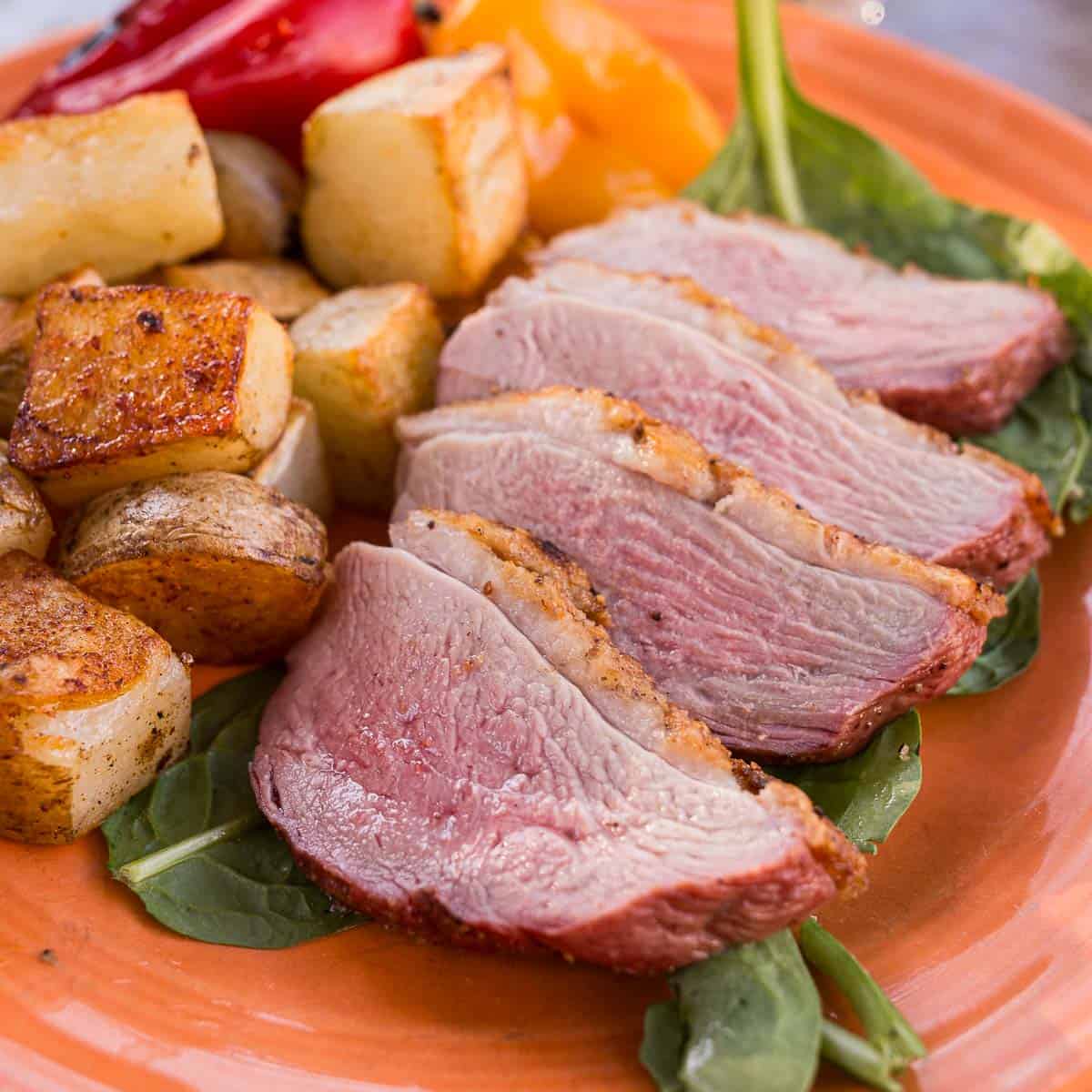
Jump to:
The duck breasts used in this post were donated by Maple Leaf Farms. They're good people - If you're looking for duck, seek them out. Phew, now I'm good with the FCC.
I love the idea of duck breasts on the grill. Crisp skin, a hint of smoke, medium-rare duck meat, and luscious duck fat.
The problem is the luscious duck fat - which, when it renders out, causes a surprisingly large grease fire in the grill. (Not that I've ever done that, oh no, not me.)
Chicken has the same problem, especially chicken thighs - lots of fat, lots of flames. I cook chicken with indirect heat to keep the fat away from the flames - which works when I want chicken cooked to 160°F. But I want my duck breast medium-rare, 145°F, with crackling crisp skin. What to do?
(Theoretically, I could make skinless duck breasts…but, ugh, I can't bring myself to do that. Crackling skin is the best part!)
When Maple Leaf Farms invited me to Duck University, I jumped at the chance. Learn about duck? I'm there.
After the cooking class, when Q&A started, I was ready to spring my question…but I was too slow. Before I could say anything, one of my fellow classmates shot her hand up and asked "how do I grill duck breast?"
It turns out that I'm not the only one with flare-up issues. There was a general muttering to the tune of "Yes, that's hard." But someone from Maple Leaf Farms threw out a suggestion - sear the duck breast, skin side down, in a pan in the kitchen to render out most of the fat. Then, move the duck to the grill to finish it.
I wish I remember who suggested this, because the idea was genius. But as a grill fanatic, I thought "Kitchen? I don't need a kitchen. I can do that right on the grill."
It worked like a charm - the duck breasts seared in a grill-safe pan, rendering lots of fat; then they went over the fire for a quick sear. I didn't want the pan full of duck fat to go to waste, so I browned a side dish of duck fat potatoes. I may enjoy the potatoes more than the duck itself. Crackling duck skin or crispy duck fat potatoes? I guess I'll have to keep sampling to figure out which I prefer._
Equipment
- Grill (I love my Weber kettle, but almost any grill will work.)
- Large, heavy, grill-safe fry pan (I use a Weber Gourmet System Griddle or a cast iron fry pan.)
Ingredients
- 4 (8-ounce) duck breasts (preferably from Maple Leaf Farms)
- 2 teaspoons kosher salt
- ½ teaspoon fresh ground peppercorn blend
Duck fat potatoes
- 1 ½ pounds russet potatoes, cut into 1-inch cubes
- ½ teaspoon fine sea salt
- 1 teaspoon paprika (preferably smoked Spanish paprika)
How to Pan Grill Duck Breast and Duck Fat Paprika Potatoes
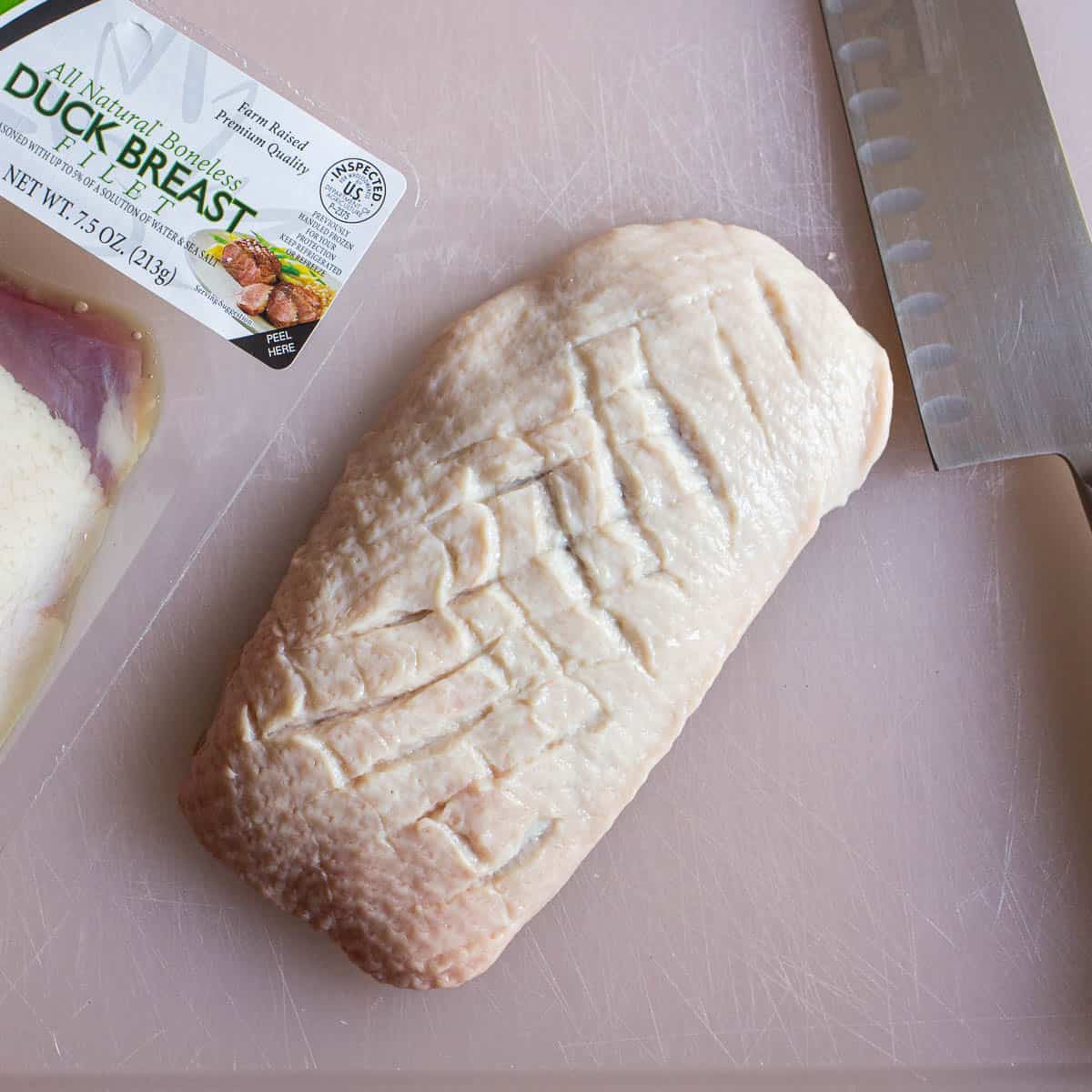
Score and season the duck breasts
Set the duck breasts on a cutting board, skin side up, and score the skin in a ½ inch diamond pattern. Cut a series of parallel lines, ½ inch apart, through the skin and into the fat, but not into the breast meat. Turn the breast 90 degrees, then cut another series of lines ½ inch apart to make a diamond pattern. Repeat on all the duck breasts. Sprinkle both sides evenly with salt and pepper, and let rest at room temperature while preheating the grill.
Par-cook the potatoes
Toss the potatoes with ½ teaspoon of salt in a medium, microwave-safe bowl. Use your hand to make a hole in the center of the pile of potatoes, pushing them to the outside of the bowl. Seal the bowl with plastic wrap and microwave until the potatoes are just done, 6 minutes in my 900 watt microwave.
Set the grill up for indirect medium-high heat (400°F) and preheat the pan
Set your grill up for indirect medium heat, and preheat the pan over direct heat. On my charcoal grill, I light a chimney full of charcoal (60 coals), wait for it to be mostly covered in gray ash, then pour it into a tight, single layer over half of the grill. I put the grill grate in the grill, brush it clean with my grill brush, and put the grill pan on the grate directly over the coals. Then, I close the lid and heat the grill pan for five minutes.
On a gas grill, I preheat with all burners on high for 15 minutes. Then I clean the grate with my grill brush, turn off half the burners, and turn the other half down to medium-high. I put the grill pan over the lit burners and heat the pan for five minutes with the lid closed.
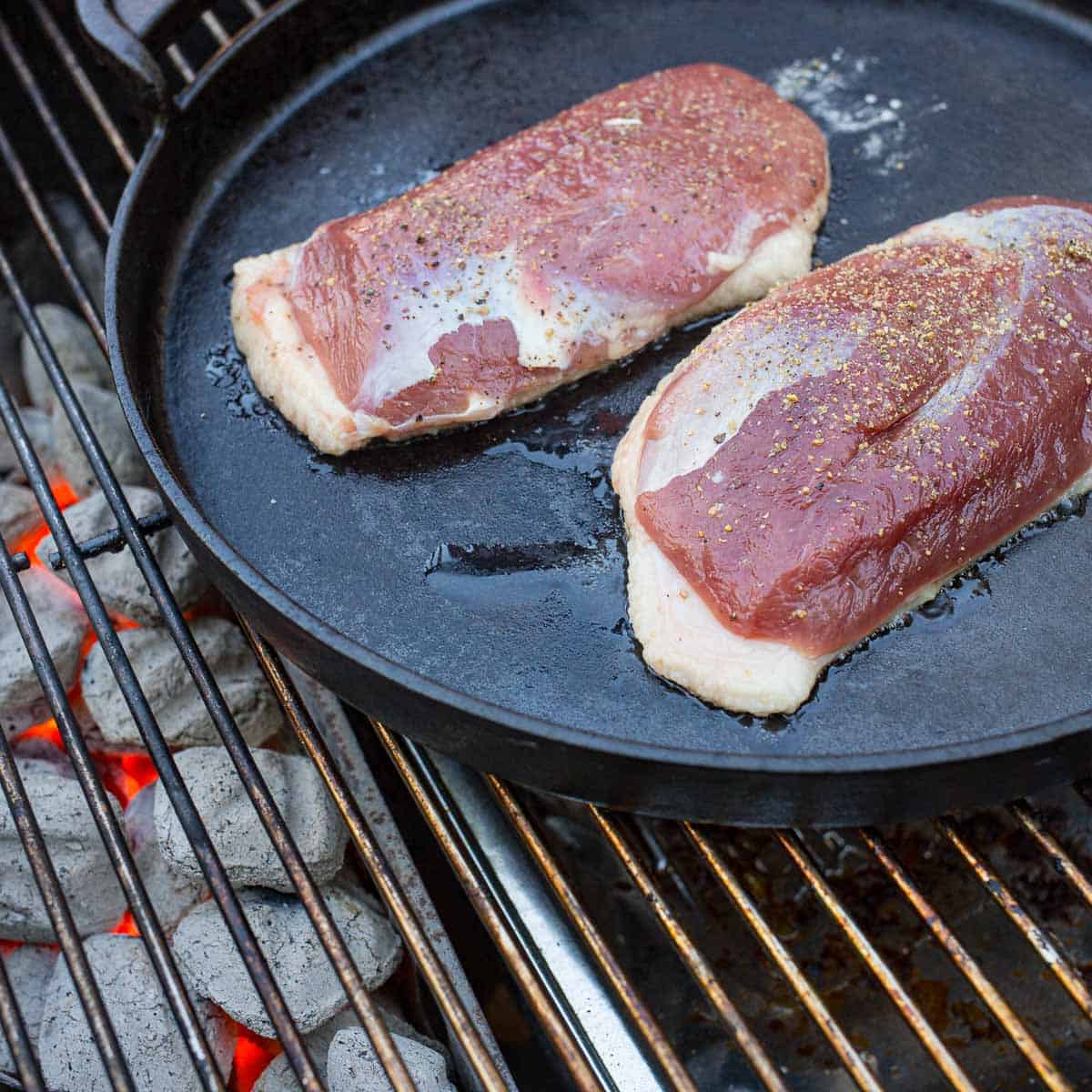
Brown the duck breasts in the pan
Move the heated pan to the indirect heat side of the grill, and set the duck breasts in the pan, skin side down, pushing down on them to make sure they have good contact with the pan. Close the lid and cook until the fat is rendered around the edges of the skin, the skin is golden brown, and the duck is 135°F measured in the thickest part with an instant read thermometer for medium-rare duck. (About 10 minutes.)
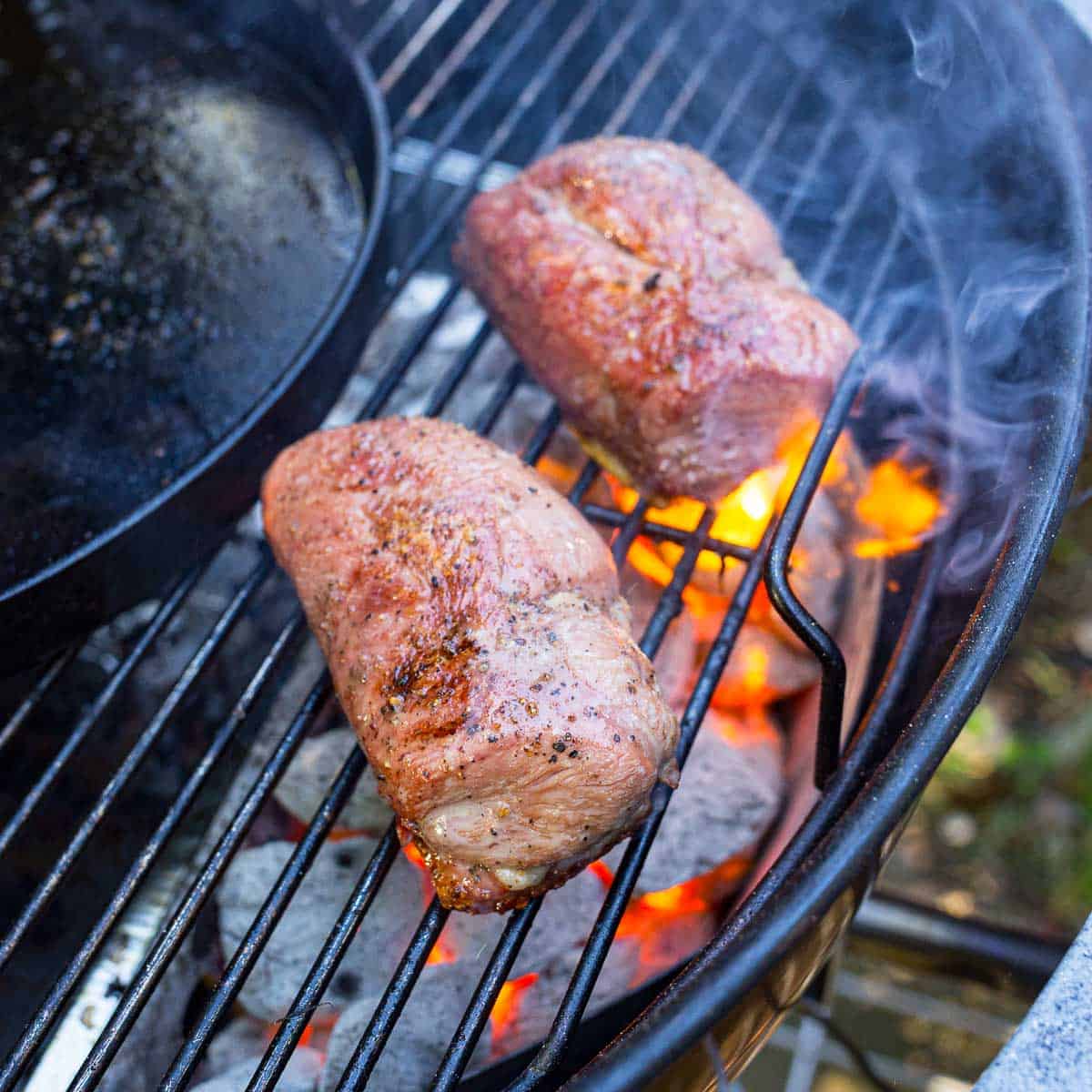
Sear the duck breasts on the grill
Move the duck breasts out of the pan and onto the grill over direct heat, starting with the skin side up. (This is not the time to go get a tasty beverage - you need to watch the breasts over open flames, especially when they are skin side down - duck fat will create quite a fire.) Grill the breasts for 2 minutes or until the bottom is starting to brown. Flip the duck skin side down and grill until the dripping fat starts flaring up, 30 seconds to 1 minute. Flip the breasts skin side up again and grill until the bottom is nicely browned, about 2 more minutes. (Move them around on the grill if you are getting uncontrolled flare-ups). Then, flip the duck skin side down again and grill until the fat starts to flare up and the skin is browned, for 30 seconds to 1 minute. Remove the duck to a plate when it reaches 140°F to 145°F internal temperature in the thickest part. Move the duck breasts to a platter.
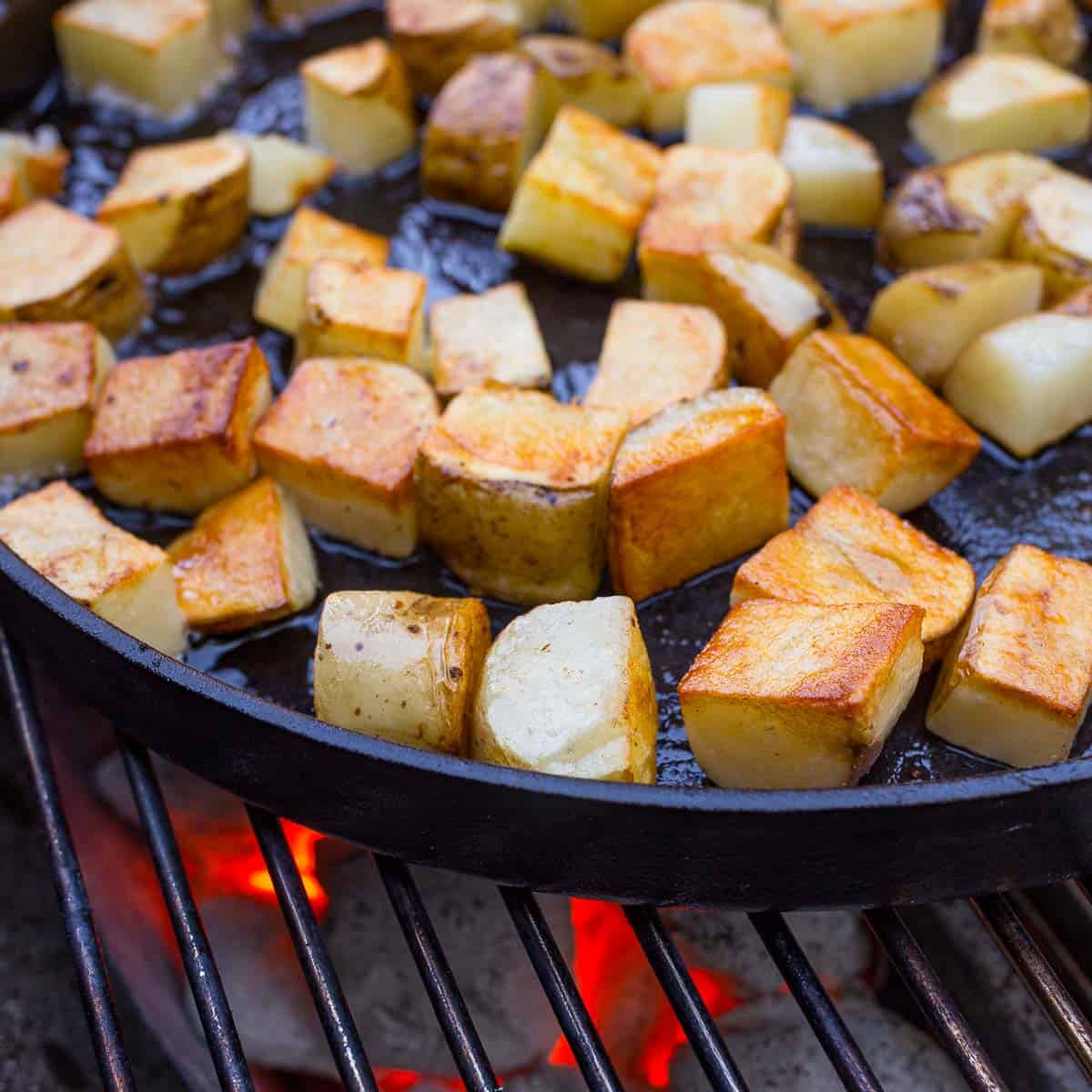
Brown the potatoes in the duck fat
The pan should have a layer of duck fat in it; carefully slide it over the direct heat part of the grill - you don't want to slosh duck fat onto the open flames. (If you do, slide the pan as far away from the flames as possible and close the lid to smother the fire, then try again.) Pour the par-cooked potatoes into the pan, then arrange them in a single layer with the cut sides down. Cook the potatoes until they are browned and crispy on the bottom for about four minutes, then flip and cook until the second side is browned and crispy for about four more minutes. Remove the potatoes to a bowl with a slotted spoon, letting the excess duck fat drip back into the pan. Sprinkle the potatoes with the teaspoon of smoked Spanish paprika and toss to coat.
Slice and serve
Slice the duck breast crosswise into ½-inch thick slices, serve with the potatoes, and enjoy!

Tips and Tricks
- Smoking the duck: To add more smoke flavor to the duck, in a charcoal grill, add a cup of soaked smoking wood chips to the coals, preferably a fruit wood, like cherry or apple. In a gas grill, wrap them in an aluminum foil packet and put them directly on the cover of a lit burner. (Or use the smoking box in your gas grill if it has one.)
- Why par-cook the potatoes? Two reasons. First, it's tough to cook potatoes through in a pan - I wind up with burnt on the outside and crunchy on the inside. Not good. Second, even if I get the potatoes cooked through, it takes a long time to get them completely done - about 20 minutes. Par-cooking avoids both of those problems; the potatoes are already cooked, we're just browning the outside in delicious, delicious duck fat.
- Make sure your pan has sides:Make sure you have sides on your grill-safe pan to contain the duck fat. This is not the time to break out a flat griddle or plancha. You do not want duck fat dripping over the side of the pan and into the flames. (Not that I've done that, and caused a huge grease fire, oh no, not me…) The Weber Gourmet BBQ Griddle has about an inch high lip, which is the minimum I would use for this recipe.
- Dry brine the duck: If you have an hour, you can get a quick dry brine. Salt the duck an hour ahead of cooking, and let it sit on the counter to dry brine. If you have even more time than that, you can get the full dry brine experience: salt the duck up to 8 hours ahead and store the duck in the refrigerator.
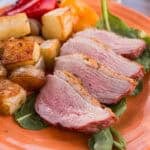
Pan Grilled Duck Breast Recipe
- Total Time: 50 minutes
- Yield: 4 duck breasts 1x
Description
Pan Grilled Duck Breast with Duck Fat Paprika Potatoes. Use a cast iron pan on your grill to get beautifully seared duck breasts, and then use the leftover fat in the pan for duck fat paprika potatoes as the side.
Ingredients
- 4 (8-ounce) duck breasts
- 2 teaspoons kosher salt
- ½ teaspoon fresh ground peppercorn blend
Duck fat potatoes
- 1 ½ pounds russet potatoes, cut into 1-inch cubes
- ½ teaspoon fine sea salt
- 1 teaspoon paprika (preferably smoked Spanish paprika)
Instructions
- Score and season the duck breasts: Set the duck breasts on a cutting board, skin side up, and score the skin in a ½ inch diamond pattern. Cut a series of parallel lines, ½ inch apart, through the skin and into the fat, but not into the breast meat. Turn the breast 90 degrees, then cut another series of lines ½ inch apart to make a diamond pattern. Repeat on all the duck breasts. Sprinkle both sides evenly with salt and pepper, and let rest at room temperature while preheating the grill.
- Par-cook the potatoes: Toss the potatoes with ½ teaspoon of salt in a medium, microwave-safe bowl. Use your hand to make a hole in the center of the pile of potatoes, pushing them to the outside of the bowl. Seal the bowl with plastic wrap and microwave until the potatoes are just done, 6 minutes in my 900 watt microwave.
- Set the grill up for indirect medium-high heat (400°F) and preheat the pan: Set your grill up for indirect medium heat, and preheat the pan over direct heat. On my charcoal grill, I light a chimney full of charcoal (60 coals), wait for it to be mostly covered in gray ash, then pour it into a tight, single layer over half of the grill. I put the grill grate in the grill, brush it clean with my grill brush, and put the grill pan on the grate directly over the coals. Then, I close the lid and heat the grill pan for five minutes.
On a gas grill, I preheat with all burners on high for 15 minutes. Then I clean the grate with my grill brush, turn off half the burners, and turn the other half down to medium-high. I put the grill pan over the lit burners and heat the pan for five minutes with the lid closed. - Brown the duck breasts in the pan: Move the heated pan to the indirect heat side of the grill, and set the duck breasts in the pan, skin side down, pushing down on them to make sure they have good contact with the pan. Close the lid and cook until the fat is rendered around the edges of the skin, the skin is golden brown, and the duck is 135°F measured in the thickest part with an instant read thermometer for medium-rare duck. (About 10 minutes.)
- Sear the duck breasts on the grill: Move the duck breasts out of the pan and onto the grill over direct heat, starting with the skin side up. (This is not the time to go get a tasty beverage - you need to watch the breasts over open flames, especially when they are skin side down - duck fat will create quite a fire.) Grill the breasts for 2 minutes or until the bottom is starting to brown. Flip the duck skin side down and grill until the dripping fat starts flaring up, 30 seconds to 1 minute. Flip the breasts skin side up again and grill until the bottom is nicely browned, about 2 more minutes. (Move them around on the grill if you are getting uncontrolled flare-ups). Then, flip the duck skin side down again and grill until the fat starts to flare up and the skin is browned, for 30 seconds to 1 minute. Remove the duck to a plate when it reaches 140°F to 145°F internal temperature in the thickest part. Move the duck breasts to a platter.
- Brown the potatoes in the duck fat: The pan should have a layer of duck fat in it; carefully slide it over the direct heat part of the grill - you don't want to slosh duck fat onto the open flames. (If you do, slide the pan as far away from the flames as possible and close the lid to smother the fire, then try again.) Pour the par-cooked potatoes into the pan, then arrange them in a single layer with the cut sides down. Cook the potatoes until they are browned and crispy on the bottom for about four minutes, then flip and cook until the second side is browned and crispy for about four more minutes. Remove the potatoes to a bowl with a slotted spoon, letting the excess duck fat drip back into the pan. Sprinkle the potatoes with the teaspoon of smoked Spanish paprika and toss to coat.
- Slice and serve: Slice the duck breast crosswise into ½-inch thick slices, serve with the potatoes, and enjoy!
- Prep Time: 30 minutes
- Cook Time: 20 minutes
- Category: Sunday Dinner
- Method: Grilling
- Cuisine: American
What do you think?
Questions? Other ideas? Leave them in the comments section below.
Related Posts
Rotisserie Duck with Honey Glaze and Drip Pan New Potatoes
Grilled Butterflied Chicken with Dry Brine
Grilled Japanese Chicken Wings
Pan Grilled Bratwurst and Sauerkraut
Smoked Duck
Enjoyed this post? Want to help out DadCooksDinner? Subscribe to DadCooksDinner via email and share this post with your friends. Want to contribute directly? Donate to my Tip Jar, or buy something from Amazon.com through the links on this site. Thank you.

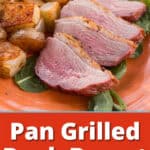
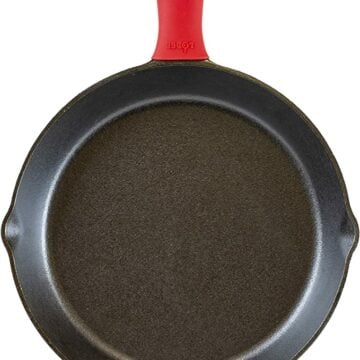
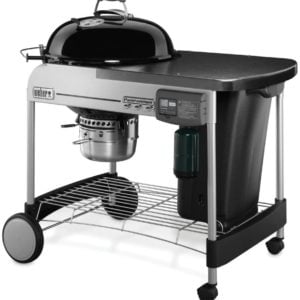
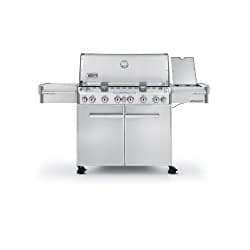
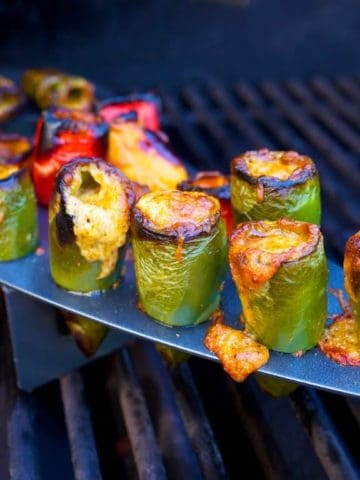
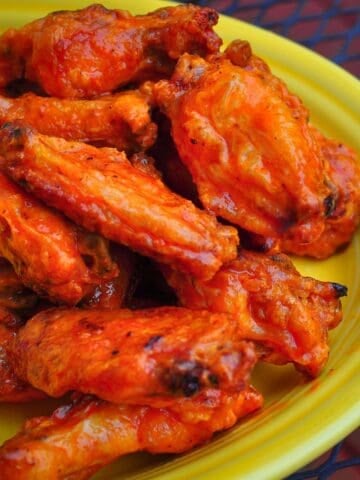
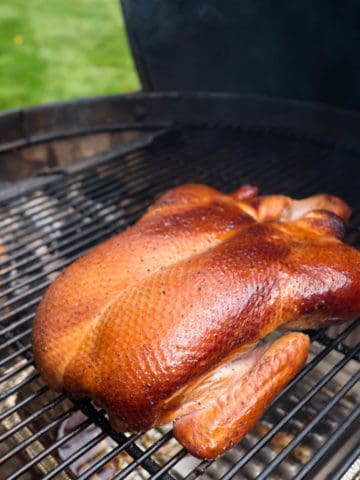
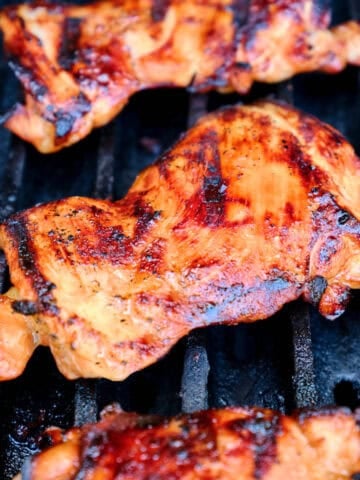
Mike Vrobel
I love pan seared duck breast. Try it, you'll love it!
Mike V @ DadCooksDinner
Absolutely! It is perfect for this recipe.
Rhonda
Can I use my old cast iron pan on the gas grill for this recipe?